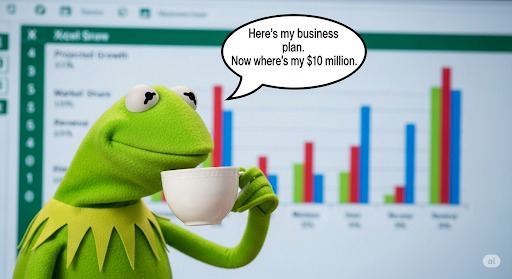Congratulations, future founder! You’re about to enter the thrilling, soul-scorching world of venture capital—where dreams go to scale (and sometimes, to die dramatically in a We Work lobby). You’ve binge-watched enough “Shark Tank” to know the look VCs give when someone’s making up numbers, and yet, here you are. It’s time to create a Business Plan that begs for millions and pretends you aren’t winging it on two hours of sleep, three cold brews, and a prayer to the Algorithm Gods. Welcome: this is your no-chill, all-snark Venture Capital Business Plan Checklist. May the hockey-stick graphs be ever in your favor.
The Executive Summary: Impress or Get Ghosted in Sixty Seconds
Let’s be honest—your 45-page Business Plan will be dutifully skimmed in the Uber, then ignored for the new meme stock on Reddit. If you can’t sell it on one page, you’re out.
Checklist for survival:

- What’s the billion-dollar idea you “manifested” in the shower?
- Why NOW? (VCs love trends. If you can connect your app to AI, Web3, or TikTok, bonus points.)
- Metrics: “We’ve grown 300% month-over-month” (No one asks, “From what to what?” This is VC math.)
- Who’s on the team? (Self-awareness: If your CTO is actually your college roommate who fixed your Wi-Fi once, maybe don’t mention that.)
- The Big Ask: How much cash? Where does it go? When do we 10x and retire early?
Remember, if your exec summary reads like a hyperactive tweetstorm, you’re doing it right. If it reads like a college essay, rewrite it in ALL CAPS and add emojis for “energy.”
Problem, Solution, and “Why People Should Care (But Don’t… Yet)”
You’re here because you think you see a gap in the universe. The “Problem” and “Solution” slides are where you pitch this as if you didn’t just make it up after three rounds of Among Us.
Bold, if questionable, truths:
- Problem: “Americans waste 22 million hours a year untangling earbuds.” VCs want pain so big it generates existential dread.
- Solution: “Wireless earbuds! But with blockchain, for some reason.”
- Can you explain your product before your demo explodes? If not, add a diagram with lots of arrows and, ideally, a dazzling sticker with “Patent Pending.”
Checklist for VC-level drama:
- Market pain point (but spice it up—basic is for bank loans, not venture funds)
- Solution so shiny it has its own Instagram page
- Any evidence this pain actually exists somewhere outside your imagination (user interviews, viral TikTok, your mom’s focus group in Florida)
- Traction! Even if it’s just “12 people joined our waitlist, five are real”
If you don’t make the VC mutter “wait, is there an app for that,” try again until you do.
Business Model: How Will You Make Money (Besides Funding Announcements)?
Here’s the dark secret: VCs don’t care if you’re profitable—they just want to know how soon they’ll get to celebrate your “Series D” exit in Aspen.
Checklist for potential liquidity:
- How do users fork over the cash? (Subscription, ads, data-mining, or selling NFTs of your backlog—honestly, it’s all fair game.)
- Who actually pays, and why haven’t they yet?
- Pricing. (“Freemium” is code for “we’re hoping someone else figures it out later.”)
- What could possibly threaten your billion-dollar valuation—besides reality?
- Lifetime Value, Customer Acquisition Cost, and lots of acronyms your cousin Googled for your pitch deck
List for the “hustle” energy:
- Viral growth hacks (explain why your meme marketing “can’t fail”)
- Partnerships with Major Brands™ (i.e., one guy you met at an industry mixer)
- Upsell, cross-sell, hard sell (all in one, obviously)
Extra tip: If your model only works when you raise $40 million a year, don’t worry. That’s practically tradition now.
Team Bios: Because “Founder Market Fit” is the New “Yale Degree”
Every VC says “We invest in people!” Translation: If your co-founder is named Chad and has a TikTok following, you’re halfway there.
Checklist for this circus:
- CEO: “Visionary” (can reply to emails before noon, sometimes)
- CTO: Knows at least one programming language—preferably not MySpace HTML
- CMO: Already planning your viral apology video
- Advisors: The one uncle who once met Mark Cuban
- Early hires or “contractors” (read: people you paid in pizza)
Describe your founding team like a Marvel cast—each with their own special power (or trauma).
If all else fails, add a group photo at a co-working space, cropped to hide the free snacks you stole for lunch.
Market Opportunity: Addressable Market So Big Even VCs Can’t Ignore You
VCs love it BIG. If your Business Plan doesn’t estimate “$100 billion TAM,” you’re not trying hard enough.
Checklist for the delusional:
- How many ~millions~ billions could you capture if everything went “flawlessly”?
- Who are your competitors, and why do they all suck, except you?
- What’s your unfair advantage? (Say “proprietary algorithm” until asked what it actually does.)
- Bar graphs up and to the right, hockey sticks, and at least one slide with “market disruption” in bold font
Hot Tip: If your market is “everyone with a smartphone,” that’s both impressive and suspicious. Go with it.
The “Use of Funds” Slide: Fancy Way of Saying “Shopping List”
You finally get to tell VCs how you’ll spend their money! (Like you’re not just going to burn half of it on first-class lattes and branded wireless chargers.)
Mandatory spending claims:
- Product dev: It’s never “done”—always “in progress,” always “just needs $2M more.”
- Marketing: Explains why you “need” a 15-person TikTok team by next Tuesday.
- Operations: Actually just keeping you from living at the office.
- Talent: “We’ll poach from Google, or at least from someone who follows Google on Twitter.”
Break it up by actual percentages, then add 20% for “misc.”
Remember, Venture Capitalists judge you less by spending specifics and more by whether your numbers look ambitious but not “completely unhinged.”
Financials: Where Dreams, Destiny, and Delusion Collide
Ah, the spreadsheet Olympics. VCs expect optimism, delusion—just not enough to report you to the SEC.
Show:
- Three-year projections (lines always go up)
- Revenue and profit, with a side of “we’ll get more efficient, promise”
- “Burn rate” (after six cold brews, you no longer care—just make it believable)
- Exit strategy (IPO, “get acquired,” or “pray a lot”)
Extra checklist drama:
- Break-even date that’s offensively soon (“Month 14, if Mercury is direct”)
- Stress-test scenarios, aka: “What if the world ends, but our app still wins?”
- Bonus pie chart. No one reads them, but they do look legit
If your financials look like abstract art, just act confident and pivot to “but our user engagement is off the charts!”
Conclusion: Congratulations, You’re Checklist-Ready (Mentally? Different Story.)

You did it. You now possess the ultimate Venture Capital Business Plan Checklist: heavy on drama, loaded with “metrics,” and caffeinated to oblivion. VCs may never read past the summary, but hey—you’re ready to crush your pitch, look bored in meetings, and possibly get memed for your “disruptive” optimism.
If you made it to the end, buy yourself a ceremonial cold brew (or five). If a VC funds you after seeing this Business Plan, DM me—because you officially believe in miracles.
